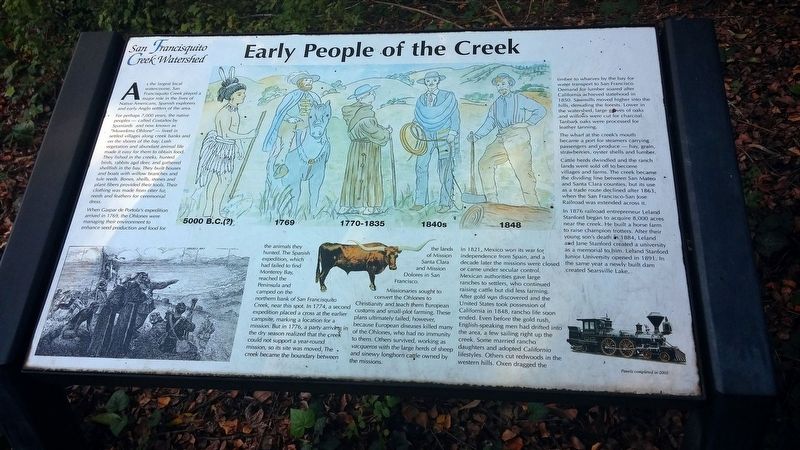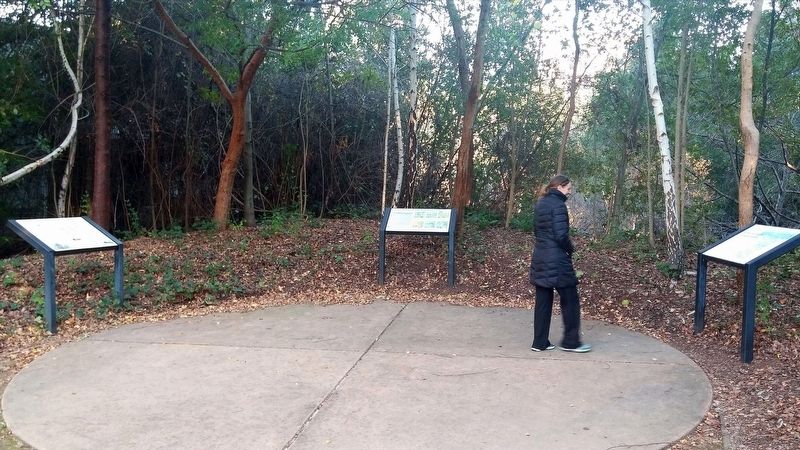Menlo Park in San Mateo County, California — The American West (Pacific Coastal)
Early People of the Creek
For perhaps 7,000 years, the native peoples -- called Costanos by Spaniards and now known as "Muwekma Ohlone" -- lived in settled villages along the creek banks and on the shores of the bay. Lush vegetation and abundant animal life made it easy for them to obtain food. They fished in the creeks, hunted birds, rabbits and deer, and gathered shellfish in the bay. They built houses and boats with willow branches and tule reeds. Bones, shells, stones and plant fibers provided their tools. Their clothing was made from otter fur, reeds and feathers for ceremonial dress.
When Gaspar de Portola's expedition arrived in 1769, the Ohlones were managing their environment to enhance seed production and food for the animals they hunted. The Spanish expedition, which had failed to find Monterey Bay, reached the Peninsula and camped on the northern bank of San Francisquito Creek, near this spot. In 1774, a second expedition placed a cross at the earlier campsite, marking the location for a mission. But in 1776, a party arriving in the dry season realized that the creek could not support a year-round mission, so its site was moved. The creek became the boundary between the lands of Mission Santa Clara and Mission Dolores in San Francisco.
Missionaries sought to convert the Ohlones to Christianity and teach them European customs and small-plot farming. These plans ultimately failed, however, because European diseases killed many of the Ohlones, who had no immunity to them. Others survived, working as vacqueros with the large herds of sheep and sinewy longhorn cattle owned by the missions.
In 1821, Mexico won its war for independence from Spain, and a decade later the missions were closed or came under secular control. Mexican authorities gave large ranches to settlers, who continued raising cattle but did less farming. After gold was discovered and the United States took possession of California in 1848, rancho life soon ended. Even before the gold rush, English-speaking men had drifted into the area, a few sailing right up the creek. Some married rancho daughters and adopted Californio lifestyles. Others cut redwoods in the western hills. Oxen dragged the timber to wharves by the bay for water transport to San Francisco. Demand for lumber soared after California achieved statehood in 1850. Sawmills moved higher into the hills, denuding the forests. Lower in the watershed, large groves of oaks and willows were cut for charcoal. Tanbark oaks were processed for leather tanning.
The wharf at the creek's mouth became a port for steamers carrying passengers and produce -- hay, grain, strawberries, oyster shells and lumber.
Cattle herds dwindled and the ranch lands were sold off to become villages and farms. The creek became the dividing line between San Mateo and Santa Clara counties, but its use as a trade route declined after 1863, when the San Francisco-San Jose Railroad was extended across it.
In 1876 railroad entrepreneur Leland Stanford began to acquire 8,000 acres near the creek. He built a horse farm to raise champion trotters. After their young son's death in 1884, Leland and Jane Stanford created a university as a memorial to him. Leland Stanford Junior University opened in 1891. In the same year a newly built dam created Searsville Lake.
Erected by Peninsula Conservation Center Foundation.
Topics. This historical marker is listed in these topic lists: Industry & Commerce • Native Americans • Settlements & Settlers • Waterways & Vessels. A significant historical year for this entry is 1769.
Location. 37° 26.859′ N, 122° 10.219′ W. Marker is in Menlo Park, California, in San Mateo County. Marker is on Alma Street south of East Creek Drive when traveling east. Touch for map. Marker is in this post office area: Menlo Park CA 94025, United States of America. Touch for directions.
Other nearby markers. At least 8 other markers are within walking distance of this marker. El Palo Alto (within shouting distance of this marker); San Francisquito Creek Watershed (within shouting distance of this marker); a different marker also named San Francisquito Creek Watershed (within shouting distance of this marker); Portola Journey's End (within shouting distance of this marker); History of Tower Well (approx. 0.2 miles away); Hostess House (approx. 0.4 miles away); Electronics Research Laboratory (approx. 0.8 miles away); Menlo Park Railroad Station (approx. 0.8 miles away). Touch for a list and map of all markers in Menlo Park.
Credits. This page was last revised on January 22, 2018. It was originally submitted on January 19, 2018, by Douglass Halvorsen of Klamath Falls, Oregon. This page has been viewed 278 times since then and 28 times this year. Photos: 1, 2. submitted on January 19, 2018, by Douglass Halvorsen of Klamath Falls, Oregon. • Andrew Ruppenstein was the editor who published this page.

